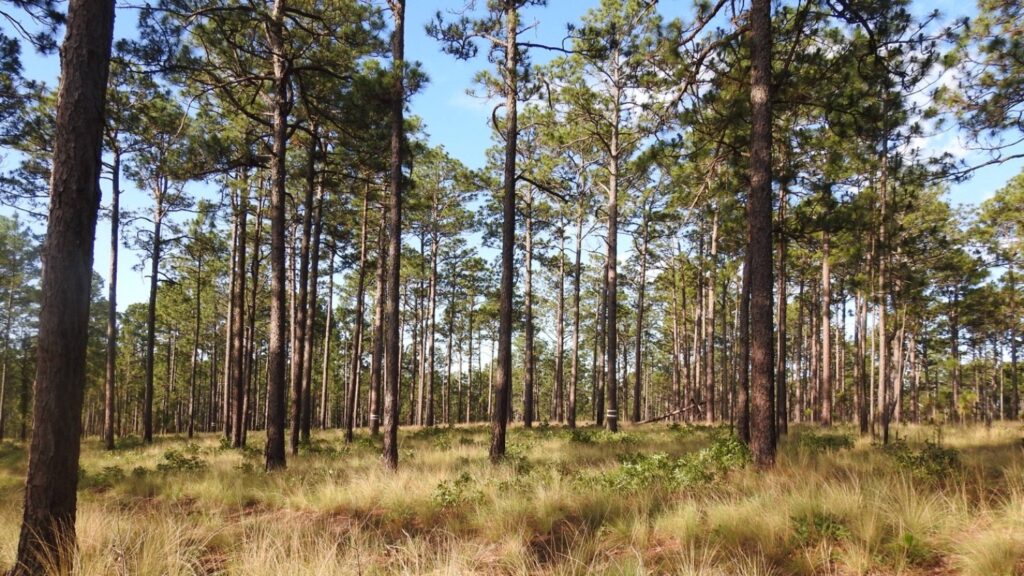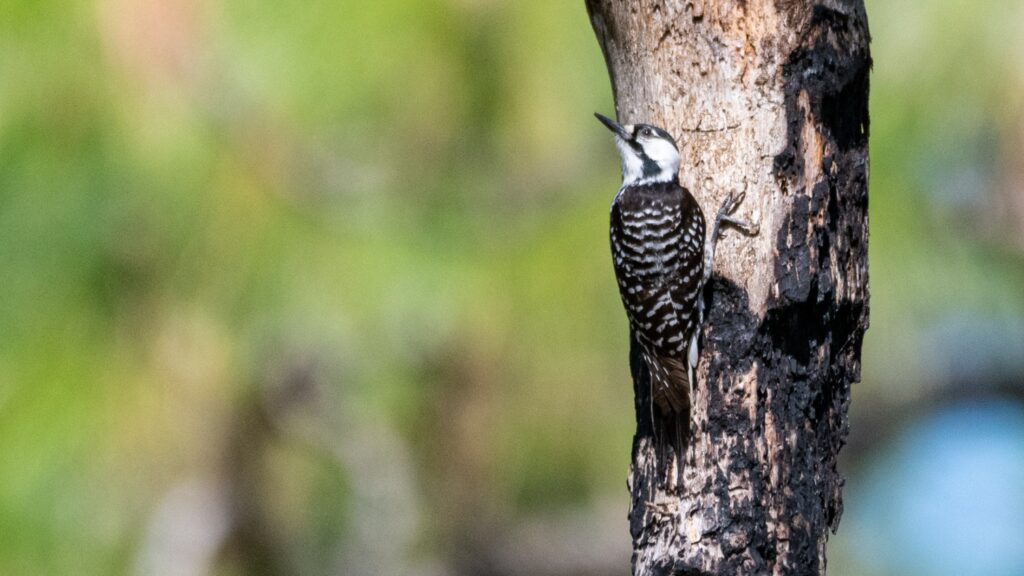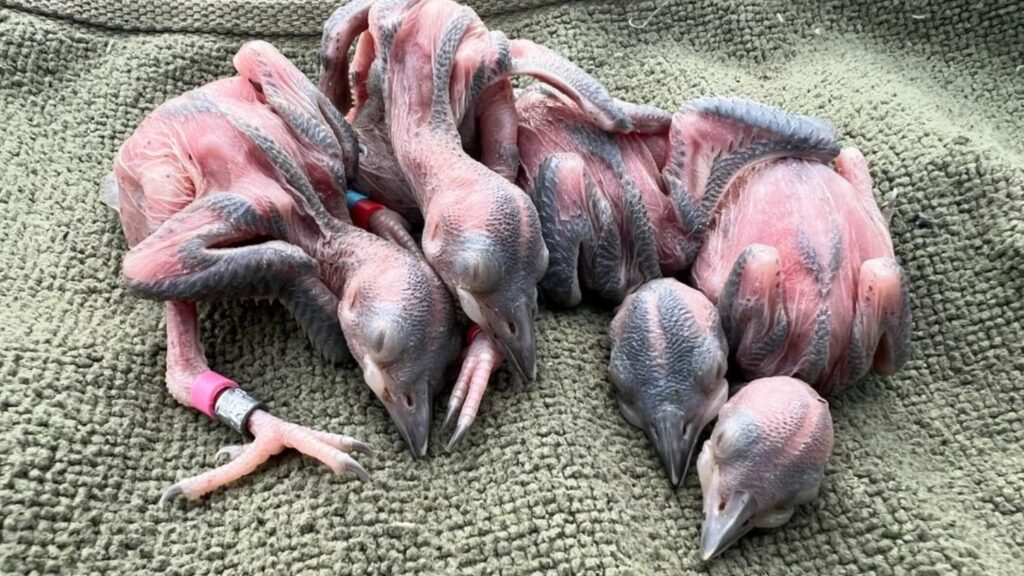Natural Resources Student Conducts Research to Save Threatened Bird Species From Extinction

Over the past four years, during the late spring and early summer, Lauren Pharr has ventured out to Sandhills Game Land in Richmond County in search of one of the Southeast’s most imperiled species: the red-cockaded woodpecker.
Pharr, a graduate student in the Department of Forestry and Environmental Resources at NC State, is conducting research on the federally-threatened bird species for her doctoral degree in fisheries, wildlife and conservation biology.
An estimated 1.6 million red-cockaded woodpeckers once inhabited nearly 100 million acres of longleaf pine forests that stretched from New Jersey to Florida and west to Texas. Now only about 15,000 individuals remain.
The species’ range has dwindled to just a few states due to fire suppression and habitat loss, according to Pharr. Red-cockaded woodpeckers exclusively excavate nesting cavities in living pine trees, particularly older longleaf pines.
Unfortunately, longleaf pine forests have declined from an estimated range of over 90 million acres to around 3 million acres today, largely because rapid and continued growth of the Southeast has made the region’s timber and land valuable.
“Over the past few decades, the longleaf pine ecosystem has faced a steady erosion as urban sprawl, industrial forestry and agricultural expansion have carved away its vast range, leaving behind scattered remnants of what was once a defining feature of the Southeast,” Pharr said.

In the 1970s, the U.S. Fish and Wildlife Service listed the red-cockaded woodpecker as an endangered species after its population fell below 10,000 individuals, prompting collaborative conservation efforts to save the species from extinction.
State and federal agencies, in partnership with nonprofits and private landowners, have since focused on the intensive restoration and management of longleaf pine forests through prescribed fire and the strategic placement of artificial cavities.
Because of these efforts, the U.S. Fish and Wildlife Service recently downlisted the species to threatened status, with Interior Secretary Deb Haaland hailing it as “a significant milestone in our nation’s commitment to preserving biodiversity.”
A “threatened” species is considered likely to become endangered in the near future, while an “endangered” species is currently in danger of extinction throughout a significant portion of its range.
While the red-cockaded woodpecker’s status has improved, it remains vulnerable to habitat loss and other factors, including severe storms and rising temperatures associated with climate change.
Climate change is already increasing the number and severity of hurricanes, wildfires and other natural disturbances that destroy pine trees, reducing suitable habitat for red-cockaded woodpeckers.
“Because the process of cavity construction can take years, it is difficult for red-cockaded woodpeckers to move to a new forest, which increases their dependence on existing old-growth forest territory, even as it shrinks,” Pharr said. “If large storms continue to knock over cavity trees and if longleaf pines then can’t replenish, the population will be decimated.”
In addition, longer rainy and dry seasons make it more difficult to effectively manage red-cockaded woodpecker habitats, particularly by means of prescribed burns, which keep hardwoods from replacing the longleaf pines.

Pharr’s research primarily focuses on the reproductive success of red-cockaded woodpeckers. More specifically, she is investigating the potential causes of a phenomenon known as partial brood loss.
Partial brood loss occurs when some, but not all, of the nestlings within a brood die. Scientists have noticed an uptick of this phenomenon in recent years, with some pointing to factors like climate change and population density.
Research indicates that warmer spring temperatures, fueled by climate change, could potentially cause a mismatch between the timing of the breeding season and the availability of insects for nestlings to feed on.
Meanwhile, a higher population density could lead to increased competition, potentially limiting the availability of food and other resources for nestlings. This is especially relevant given the decline of longleaf pine forests.
Pharr recently completed her fourth and final season of data collection in the Sandhills Game Land. The 60,000-acre nature reserve features large tracts of mature longleaf pine forests, making it a prime habitat for red-cockaded woodpeckers.
During her annual trips to the Sandhills Game Land, Pharr used a pole with a camera to check for nesting sites. When she found an active nest, she climbed longleaf pine trees to extract the nestlings. She weighed the nestlings and put color-coded bands on their legs.

Pharr tracked the progress of nestlings for several weeks before using a spotting scope to look for the color-coded bands to identify those that fledged — or developed the feathers and wing muscles needed to leave the nest.
In her remaining time at NC State, Pharr plans to continue reviewing her field data in hopes of producing multiple research papers that help provide the information managers need to continue protecting red-cockcaded woodpeckers.
“It is rewarding to know that whatever information I find will be beneficial to species’ conservation, and I see myself continuing work in the threatened and endangered species space,” Pharr said.
She added, “As for my partners and collaborators regarding the recent downlisting, my reminder is the same. As we move forward, let’s remain focused on our mission. Our work is far from over, and the positive change we’ve fostered is a testament to our dedication. We will persevere.”
This post was originally published in College of Natural Resources News.
- Categories:


